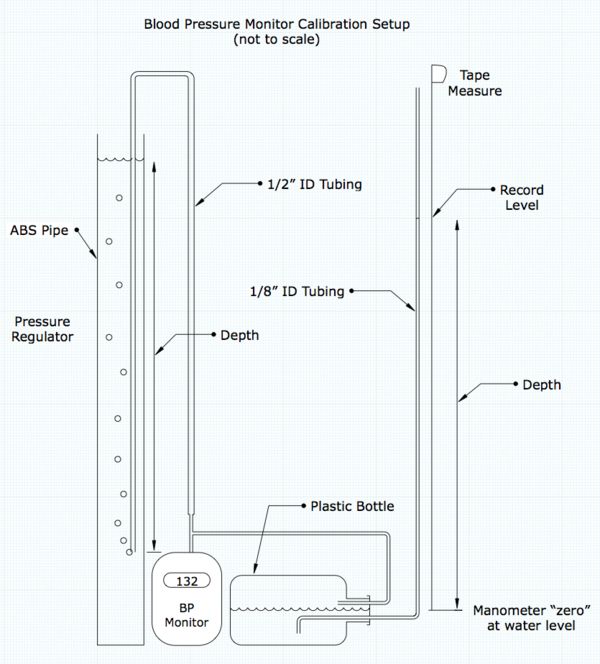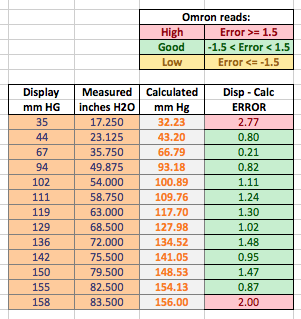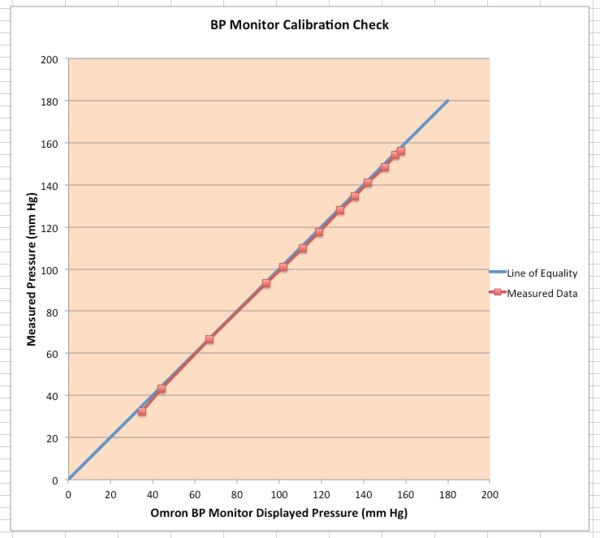DIY Blood Pressure Monitor Calibration
Mar 28, 2016 21:02:58 #
About two years ago I was diagnosed with slightly elevated blood pressure (BP). My doctor recommended I go on BP medication and buy a home BP monitor to track my progress, so I purchased the Omron HEM-7901T Blood Pressure Monitor.
I recently went back to my doctor to review my health situation and mentioned that my BP was still elevated but relatively steady according to my home measurements. The doctor wanted to verify the accuracy of my home monitor and recommended I bring it to the office for a calibration check. He said they would compare the reading on my monitor with a manually taken BP measurement.
This did not sound overly scientific or accurate to me, so I took a stab at making my own BP pressure monitor calibrator. And rather than rely on a second pressure gauge that may or may not be calibrated and accurate I chose to use a column of water as my standard, so it would be as reliable as gravity itself.
The principle for calibration is quite simple: replace the cuff with a water manometer and compare the height of the water column in inches against the digital readout in millimeters of mercury (mm Hg) at several values over the range of interest. The conversion factor is 1 mm Hg = 0.535 inches H2O. Here are a few water column equivalents for key BP values:
- 180 mm Hg = 96.35 inches H2O
- 160 mm Hg = 85.64 inches H2O
- 120 mm Hg = 64.23 inches H2O
- 80 mm Hg = 42.82 inches H2O
The calibration is easy in principle, but a bit more challenging to implement because the pressure readings on the monitor are updated only intermittently and they fluctuate greatly during inflation/deflation. Ideally you want the BP monitor to hold steady at various pressures while you get an accurate reading of the water column, and for this you need an adjustable pressure regulator. Fortunately a simple regulator can be implemented by using an air column submerged to various depths in water (essentially an inverted manometer). See the diagram below for the setup.
I made the manometer with 8 ft of 1/8 ID clear plastic tubing and a 1-quart plastic apple juice bottle with a 1.5 diameter plastic lid. I drilled 2 holes into the lid to secure the air and water tubes. The regulator was made with an 8 ft piece of ABS pipe 3 diameter capped at one end and 16 ft of 1/2" ID clear plastic tubing. I also needed a few other odds and ends (Tee fitting, 1/8 to 1/2" adapter, weight to submerge the air tube of the regulator, etc) to put it all together.
Below are the results of my calibration check, and I am VERY PLEASED with the results. I can provide assembly/usage details for anyone interested in calibrating their own monitor.
I recently went back to my doctor to review my health situation and mentioned that my BP was still elevated but relatively steady according to my home measurements. The doctor wanted to verify the accuracy of my home monitor and recommended I bring it to the office for a calibration check. He said they would compare the reading on my monitor with a manually taken BP measurement.
This did not sound overly scientific or accurate to me, so I took a stab at making my own BP pressure monitor calibrator. And rather than rely on a second pressure gauge that may or may not be calibrated and accurate I chose to use a column of water as my standard, so it would be as reliable as gravity itself.
The principle for calibration is quite simple: replace the cuff with a water manometer and compare the height of the water column in inches against the digital readout in millimeters of mercury (mm Hg) at several values over the range of interest. The conversion factor is 1 mm Hg = 0.535 inches H2O. Here are a few water column equivalents for key BP values:
- 180 mm Hg = 96.35 inches H2O
- 160 mm Hg = 85.64 inches H2O
- 120 mm Hg = 64.23 inches H2O
- 80 mm Hg = 42.82 inches H2O
The calibration is easy in principle, but a bit more challenging to implement because the pressure readings on the monitor are updated only intermittently and they fluctuate greatly during inflation/deflation. Ideally you want the BP monitor to hold steady at various pressures while you get an accurate reading of the water column, and for this you need an adjustable pressure regulator. Fortunately a simple regulator can be implemented by using an air column submerged to various depths in water (essentially an inverted manometer). See the diagram below for the setup.
I made the manometer with 8 ft of 1/8 ID clear plastic tubing and a 1-quart plastic apple juice bottle with a 1.5 diameter plastic lid. I drilled 2 holes into the lid to secure the air and water tubes. The regulator was made with an 8 ft piece of ABS pipe 3 diameter capped at one end and 16 ft of 1/2" ID clear plastic tubing. I also needed a few other odds and ends (Tee fitting, 1/8 to 1/2" adapter, weight to submerge the air tube of the regulator, etc) to put it all together.
Below are the results of my calibration check, and I am VERY PLEASED with the results. I can provide assembly/usage details for anyone interested in calibrating their own monitor.
Schematic of calibrator

Numerical test results

Graph of test results

Mar 28, 2016 21:19:08 #
JohnFrim wrote:
About two years ago I was diagnosed with slightly ... (show quote)
Your original BP reading was "a little elevated" what was it then ? What is it now? Are you over weight, what kind of diet do you have? I realize tht these re very personal questions. If you don't answer I will understand.
Mar 28, 2016 21:30:07 #
boberic wrote:
Your original BP reading was "a little elevated" what was it then ? What is it now? Are you over weight, what kind of diet do you have? I realize tht these re very personal questions. If you don't answer I will understand.
Let's just say it was borderline concern, and it hasn't changed up or down significantly. I am not overweight, I eat a reasonably healthy diet... but do like desserts, and I do some moderate exercise. I may need to try a different medication or make a few more lifestyle adjustments to keep it in check.
At least I now know I can trust my home measurements.
Mar 28, 2016 22:05:27 #
JohnFrim wrote:
Let's just say it was borderline concern, and it hasn't changed up or down significantly. I am not overweight, I eat a reasonably healthy diet... but do like desserts, and I do some moderate exercise. I may need to try a different medication or make a few more lifestyle adjustments to keep it in check.
At least I now know I can trust my home measurements.
At least I now know I can trust my home measurements.
Thanks for sharing this information.
I noticed a discrepancy between our Omron (HEM_711DLX) and the mercury-based system at the doctor's. As I recall, the diastolic was about 20 pts. lower on the Omron.
My idea was to calculate how much the comparison varied over several readings, average them, and make adjustments accordingly. I'm sure that would be less accurate than what you're doing because of too many variables. I would really like to have the doctor use the Omron on a variety of patients and compare results with his cuff to see whether the difference is always off by the about the same amount. In the meantime, out cuff remains unused, and we've had it too long to return.
Any thoughts?
Mar 28, 2016 22:35:59 #
vicksart wrote:
Thanks for sharing this information. br br br I ... (show quote)
I think anytime a human is in the loop you have a chance of an error. Taking a manual BP reading takes skill, and no single reading would be reproducible exactly by the same person, let alone between testers, let alone between left and right arm, and at different points in time.
A manual reading is done by listening for blood flow characteristics in the artery and following a "moving" pressure reading on the manometer or gauge. The systolic is probably fairly easy to nail down because the stethoscope goes from silence to pulsation, but the diastolic depends on a change in the nature of the sound. Medical personnel taking blood pressure may have different notions of when diastolic pressure is reached.
The Omron senses the pressure oscillations in the cuff and decides when systolic and diastolic pressures have been reached based on an algorithm. I have to trust that Omron did the clinical trials with a sufficient number of subjects/trials to have a good algorithm.
Of course, the systolic/diastolic output of the Omron can only be as good as the accuracy of the transducer. My DIY calibrator checks the accuracy of the pressure transducer itself independent of any algorithm, and I have reconfirmed my confidence in my monitor.
Regarding your device, if you think the systolic reading is correct but the diastolic is low I would suspect the human element. As you can see from my graph, the pressure transducer is very linear, so even a single point (systolic) should confirm that it is reading correctly.
Mar 29, 2016 05:57:30 #
johnst1001a
Loc: West Chester, Ohio
The nurses and Doctors also get various readings with their blood pressure machines. I would have my physical, and one would get a result 20mm apart from the other in a matter of minutes between readings. And consistently, as it happened each year. The nurse always got a higher number. My home unit was usually the same or similar as the Doctor's readings.
Mar 29, 2016 07:51:50 #
mas24
Loc: Southern CA
I own the wrist version of a monitor that doctors don't recommend. I take my blood pressure once a day with it. Uses 2 AAA Batteries. I get almost the same results from the doctor's monitor.
Mar 29, 2016 07:55:50 #
And then there is the "white coat syndrome" that I have where my reading is 20+ higher in the office.
Mar 29, 2016 08:25:09 #
JohnFrim wrote:
Let's just say it was borderline concern, and it hasn't changed up or down significantly. I am not overweight, I eat a reasonably healthy diet... but do like desserts, and I do some moderate exercise. I may need to try a different medication or make a few more lifestyle adjustments to keep it in check.
At least I now know I can trust my home measurements.
At least I now know I can trust my home measurements.
Thanks for the reply. First let me say that I am NOT a physician. That said-"a little elevated" may not be a reason to take meds. Normal BP is usually 120/80/. Anything under 140/90. say 135/85 does not warrant treatment, any thing 140 or over does. Again just sayin.
Mar 29, 2016 08:26:15 #
Mar 29, 2016 08:37:07 #
These DIY arm monitors are not expensive - certainly not when considering the value of the info they provide. So for those concerned about accuracy, buy two monitors of different makes - check one against the other and I think you will find that results will be close. Remember that blood pressure can vary 10 or so points in the space of a few minutes. Use a chart from the internet to monitor the results. Take three readings over 20 minutes. Record all three each day. You will soon see a useful picture emerge. Record time of day each day. Use a spreadsheet. Against popular opinion vary the time.
Mar 29, 2016 09:15:17 #
boberic wrote:
Thanks for the reply. First let me say that I am NOT a physician. That said-"a little elevated" may not be a reason to take meds. Normal BP is usually 120/80/. Anything under 140/90. say 135/85 does not warrant treatment, any thing 140 or over does. Again just sayin.
I tend to agree with what you are saying. "Normal" is based on population averages with little regard to underlying causes. If stiffening of the blood vessel walls is an expected consequence of aging then an increase in blood pressure may be "normal" as we get older. Many health relationships are based on correlations, which do NOT link cause to effect. Furthermore, a lot of medical treatment is aimed at the symptoms and not the cause (my first car had water leaking into the trunk from "somewhere"; the easiest treatment was to punch a hole into the deepest part and let the water run out!!!).
I would like to know WHY my blood pressure is elevated so that I can treat the cause instead of just "expanding the plumbing" to reduce the pressure. With my current vasodilator meds I think my body is reacting to the relaxed blood vessels and compensating with increased cardiac output to maintain the slightly elevated pressures because something in the feedback loop says "I need more blood flow".
Bottom line is that I am not really concerned, but I will be reassessing the requirement and the approach for my meds. Perhaps trying a different medication targeted at a different aspect of the BP control system will help find the cause.
Mar 29, 2016 09:18:33 #
oldnomad wrote:
And then there is the "white coat syndrome" that I have where my reading is 20+ higher in the office.
The nurse taking your readings must be VERY attractive!!!
Actually, the (fear) syndrome can extend to just looking at your home machine where you dread getting yet another high reading.
Mar 29, 2016 09:20:07 #
johnst1001a wrote:
The nurses and Doctors also get various readings with their blood pressure machines. I would have my physical, and one would get a result 20mm apart from the other in a matter of minutes between readings. And consistently, as it happened each year. The nurse always got a higher number. My home unit was usually the same or similar as the Doctor's readings.
Try asking for an ugly nurse... ;-)
Mar 29, 2016 09:28:49 #
Delderby wrote:
These DIY arm monitors are not expensive - certain... (show quote)
My useful picture is that my BP readings are inversely related to my heart rate, and that is why I believe my body is trying to maintain some sort of blood flow, which is secondary to an oxygen/nutrient demand or waste/metabolite elimination signal. As with most closed loop control systems, something somewhere in the system has changed and the feedback loop is responding. Elevated BP is only an observed result of one small part of the system.
If you want to reply, then register here. Registration is free and your account is created instantly, so you can post right away.



